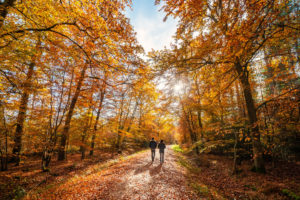Celebrating the heritage wonders of Hampshire
July 15, 2020
With a population of 1.8 million, Hampshire is one of the most bustling and vibrant corners of the UK.
Sheltered harbours, beautiful river valleys, crucial look-out points along the South Downs and life-giving water springs have been central themes in the story of this scenic county.
Today you don’t have to step far from the hustle and bustle of urban life in the “Solent City” to find the beautiful tranquility and rich heritage of the South Downs National Park – with Hampshire making up a third of its area.
Many would agree the western end of the South Downs National Park has a quite different feel to the eastern extremity that climaxes in the dramatic Seven Sisters cliffs. This is a land of steep wooded hills, royal forests, heathlands, hop gardens, hidden valleys, trout-filled chalk streams and leafy market towns.
As we mark Hampshire Day, Anooshka Rawden, Cultural Heritage Lead for the National Park, shares 10 fascinating heritage facts that underpin the story of this remarkable county.
- Hampshire takes its name from the settlement that is now the city of Southampton. Southampton was known in Old English as Hamtun, roughly meaning “village-town”, so its surrounding area or scīr became known as Hamtunscī The old name was recorded in the 11th century Domesday book as Hantescire, and from this spelling, the modern abbreviation “Hants” derives.
- Hampshire was once linked through river valleys now under the English Channel to Europe. The people familiar with this changing landscape capitalised on its diverse natural resources, following migrating animals and adapting to the seasons. By 4,000 BCE farming became increasingly important, with some deforestation taking place and the first monuments emerging, such as Neolithic long barrows to commemorate the dead. This adaptation of the landscape continued with burial mounds in the Bronze Age and the proliferation of fortified hilltop settlements by the Iron Age. One of the best examples of an Iron Age fort survives at Old Winchester Hill, protected as a Scheduled Monument. If you want to experience the prehistoric in Hampshire, you can book a visit to Butser Ancient Farm, which reopened on the 4 July.
- Hampshire emerged as the centre of what was to become the most powerful kingdom in Britain, the Kingdom of Wessex, with its capital in Winchester, which started life as a fortified burgh. Today this key period of history is symbolised in Winchester by a commanding statue of Alfred the Great. The powerful King of Wessex managed to hold off the mighty advances of the Vikings – who already controlled most of the north and east of England under the Danelaw – and lay the foundations for unification of the Saxon kingdoms. Why not book a visit to Winchester City Museum to learn more? Today the charming city of Winchester marks the start of the South Downs Way – a 100-mile trail along the chalk escarpment that has been walked by humans for around 5,000 years.

Old Winchester Hill
- The beauty of the Hampshire countryside has provided inspiration to some of England’s most celebrated writers. Jane Austen’s 17th century house in Chawton holds a treasure trove of memorabilia, including her writing desk. This lovely museum is planning to reopen in the summer. Nearby is the home of Jane’s elder

Jane Austen’s House brother, Chawton House, which includes a library celebrating women writers from 1600-1830 – you can visit the gardens and enjoy takeaway tea if you book in advance. Selborne was home to the Reverend Gilbert White, whose “The Natural History and Antiquities of Selborne” has remained print since 1789. You can visit Gilbert White’s House and Gardens to learn more about the man who inspired Charles Darwin and David Attenborough – book a visit to the gardens, enjoy takeaway food and a chance to celebrate White’s 300th birthday. A landscape of continuous inspiration to poets, John Keats stayed in Winchester in the summer and autumn of 1819, during which time he produced a series of masterpieces. Visitors can follow the ‘Keats Walk’ celebrating his famous ode ‘To Autumn’, written after a walk along the River Itchen. Poet Edward Thomas lived in the village of Steep from 1913 to 1916, taking inspiration from the countryside around him. You can follow a circular walk to see the sites familiar to Thomas, and the poet’s stone that commemorated him.
- Watercress was in great demand due to its perceived health benefits during the Victorian era and this lead to commercial watercress farms establishing themselves throughout Hampshire. The geology of the area with flat, chalky downlands provide perfect conditions for the plants to thrive. Today The Watercress Line, or Mid-Hants Railway, is one of the most successful heritage railways in the UK. Running from New Alresford to Alton where it connects to the National Rail network, the line gained its popular name in the days when it was used to transport locally-grown watercress to markets in London. The Watercress Line reopened on 11 July.
-

Alice Holt Forest Alice Holt Forest in the north of the county played a key role in the defence of the country during some of our most turbulent times, including the Napoleonic wars. Its oaks supplied the shipbuilding in Portsmouth and today the timbers’ route is celebrated with the Shipwrights Way, which runs 50 miles through the South Downs National Park from Alice Holt and down to the Historic Dockyard, the home of HMS Victory.
- Petersfield is the second largest market town in the National Park. Although evidence for Bronze Age activity has been found at Petersfield Heath, the focus of its development was a then-remote church dedicated to Saint Peter. The surrounding area was known as St Peter’s Field. The prosperity of medieval Petersfield was based on wool , with the root of its economic success cemented in the name ‘Sheep Street’. By the 17th century associated industries of leather and tanning emerged. John Goodyer (1592–1664), a noted botanist, lived in the town and spent time in the surrounding countryside and is credited with introducing the Jerusalem artichoke to our plates. His home survives in the area of the town known as The Spain, and his reputation, such that during the English Civil War, a Royalist Commander ordered that his home and family should receive defence and protection. The town’s new museum will be opening in 2021 to celebrate the stories of Petersfield and the wider South Downs.
 Hampshire is home to arguably one of the most scenic churches in Britain. Often called the “The little church in the field”, St. Hubert’s began as a 9th century Saxon church, before Earl Godwin (whose son was King Harold, defeated by William and Conqueror and the last Saxon king of England), had the chapel built in around 1030. Its interior includes some magnificent and rare medieval wall paintings dating from around the 1330s. In 1864, when the wall paintings were rediscovered, it was believed a significant scene referred to the life of St. Hubert, but prior to this, maps refer to it as the Church of St. Peter and St. Paul who can be found either side of the east window. You can enjoy a wonderful virtual tour of the church here.
Hampshire is home to arguably one of the most scenic churches in Britain. Often called the “The little church in the field”, St. Hubert’s began as a 9th century Saxon church, before Earl Godwin (whose son was King Harold, defeated by William and Conqueror and the last Saxon king of England), had the chapel built in around 1030. Its interior includes some magnificent and rare medieval wall paintings dating from around the 1330s. In 1864, when the wall paintings were rediscovered, it was believed a significant scene referred to the life of St. Hubert, but prior to this, maps refer to it as the Church of St. Peter and St. Paul who can be found either side of the east window. You can enjoy a wonderful virtual tour of the church here.- The Hampshire countryside is dotted with some amazing stately homes and gardens. Hinton Ampner, owned by the National Trust, is noted for its stunning gardens and collection of fine paintings, including a set of paintings of the four seasons by Jacob de Wit, depicting cherubs painted in a three-dimensional monochrome style.
- The South Downs played a key role in D-Day as a training area holding the thousands of men about to be sent to Europe. In May 1944, Field Marshal Montgomery, addressed the Royal Ulster 2nd Battalion Rifles, based at Grenville Hall, outside the village. “Monty” stood on his jeep’s bonnet to talk to the troops who clustered around their hero. Droxford then hosted a secret meeting of the War Cabinet in June 1944 where Churchill and others met on the Royal train to agree to delay D-day by one day.
 Anooshka says: “Hampshire has such an incredible mix of heritage – truly a place where Town meets Down. Many of Hampshire’s cultural and creative venues have been hit hard by the impact of COVID-19 and are now starting to open their doors again to visitors.
Anooshka says: “Hampshire has such an incredible mix of heritage – truly a place where Town meets Down. Many of Hampshire’s cultural and creative venues have been hit hard by the impact of COVID-19 and are now starting to open their doors again to visitors.
“This summer provides a great opportunity to support those venues at a time when they need it most.”
- Please check the website of the venue for opening times and remember that many require pre-booking.
